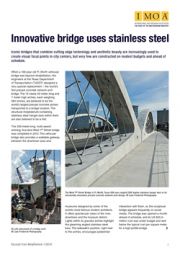Welcome to ‘Stainless Solutions’ from IMOA. Each month, we will cover a different stainless steel issue with tips on design and specification, and links to technical resources. This month’s issue focuses on stainless steel use in vehicular, rail and pedestrian bridges. |
| Stainless Steel in Vehicular, Rail and Pedestrian Bridges |
|
Bridge engineers are increasingly exploiting the unique characteristics of modern austenitic and duplex stainless steel alloy families to solve a range of challenges associated with bridges and highways. Each family is defined by its microstructure (i.e. austenite or, for duplex, roughly equivalent levels of austenite and ferrite) but includes alloys with different levels of corrosion resistance and strength.
Both alloy families provide strength and substantially improved corrosion resistance relative to carbon, alloy or weathering steels. They also have better fire performance, ductility and energy absorption characteristics (impact toughness, fatigue and seismic performance) than standard bridge steels. The duplex family is more resistant to certain types of corrosion and provides higher strength levels in the annealed condition. The austenitics can achieve higher strength levels when cold worked, have better low temperature toughness and somewhat better fire and energy absorption characteristics than the duplexes |
Bridge webinar |
 |
A two-hour webinar on the use of structural stainless steel in bridge and highway design was given in late 2017 to educate bridge designers and fabricators. The recording is available on YouTube. While it covers a wide range of applications, there is a significant focus on primary structural sections. The speakers are international experts in stainless steel fabrication, selection and structural and bridge design: |
|
Nancy Baddoo, Steel Construction Institute (SCI)
Juan Sobrino, Pedelta
Graham Gedge, ARUP
Dan Fitzwilliam, T.Y. LIN
Matt Hebdon, Virginia Tech
Catherine Houska, TMR Consulting
Jim Fritz, TMR Consulting
Stainless Steel Bridge Applications
The webinar and the resources provided at the end of this article discuss how the austenitic and duplex stainless steel families are being used in bridge and highway applications. Some of these applications are listed below.
Austenitic and duplex stainless steels:
- Primary pedestrian bridge structural sections,
- Concrete reinforcing bar and welded wire reinforcement,
- Signage and poles, and
- Seismic retrofits
Austenitic stainless steels:
- Lower load vehicular structural sections with minimal chloride exposure,
- Pedestrian bridge structural sections,
- Expansion joints and pins,
- Guardrails,
- Tunnel wall panels and bolting,
- Personal safety netting, and
- Electrical boxes
Duplex stainless steels:
- Primary and secondary vehicular and rail bridge structural sections,
- Highly loaded bolting*,
- Concrete pre- and post-tensioning cable systems, and
- Concrete bridge diaphragms
Note: While alloys from the precipitation-hardened stainless steel family have been used in bridge bolting applications because of their high strength, they are less corrosion resistant and susceptible to hydrogen embrittlement. Although its strength is lower, duplex stainless steel bolting is increasingly being used both for its significantly improved corrosion resistance and its improved elongation and energy absorption characteristics.
|
|
Bridge Project Examples
Case studies, articles and papers on the applications for stainless steel in bridges are provided in the resource section. The earliest known concrete reinforcement application for stainless steel was in the late 1930’s and expansion joints are also an early application.
Duplex alloys have become the preferred stainless steels for primary structural bridge sections because of their high strength and corrosion performance. The first railway bridge application was in Kungalv, Sweden (2002). Since then, numerous rail bridge projects have used duplex stainless steel for the primary structural beams, including four railway bridges in Stockholm, Sweden (anticipated 2018 completion). |
 |
The first vehicular bridge to use duplex stainless steel for the primary structural beams was the Cala Galdana Bridge in Menorca, Spain (2005). Notable subsequent vehicular bridges include the immense Stonecutters Bridge in Hong Kong (2009) and the West 7th Street Bridge Ft. Worth Texas, US.
Pedestrian bridge examples include ARUP’s Helix Bridge in Singapore (2010), T.Y. LIN’s Harbor Drive Bridge in San Diego (2011) and Pedelta’s two spectacular arched duplex stainless steel bridges under construction in Fort York Park, Toronto.
|
|
Resources
Design, selection, specification and fabrication assistance is available from industry associations, welding supply companies, stainless steel producers, and structural and metallurgical engineering consulting firms with structural stainless steel experience. Links to some of these helpful resources are provided below.
Structural Design Resources & Technical Papers
Applications
Fabrication & Specification Resources
|
| Stainless Steel Library |
|
Download a free Stainless Steel Library (zip file, 735 MB) with over 550 pdfs covering building and construction applications, selection, specification, fabrication, sustainability and other common questions. |
| Stainless Solutions e-newsletter archive |
|
For previous issues or to subscibe to the e-newsletter, please visit the archive page. |
| Continuing Education – American Institute of Architects (AIA) |
|
IMOA is an AIA continuing education system approved provider with eight 1-hour programs that are registered for both live face-to-face and distance learning credit.
1. Stainless Steel Sustainable Design
2. Bioclimatic Design With Stainless Steel Weather Screens
3. Stainless Steel Structural Design
4. Stainless Steel Specification For Corrosive Applications
5. Deicing Salt: Stainless Steel Selection to Avoid Corrosion
6. Stainless Steel Finish Specification
7. Advanced Stainless Steel Specification and Problem Avoidance
8. Specification of Stainless Steel Finishes and Grades For Corrosive Applications
9. Planning for Disaster: Material Selection for More Resilient Design
For more information or to schedule a workshop contact Catherine Houska, 412-369-0377 or email chouska@tmr-inc.com. |
| What is IMOA? |
|
IMOA (International Molybdenum Association) is a non-profit industry association, which provides technical information to assist with successful specification of molybdenum-containing materials. Molybdenum is an element. When it is added to stainless steel, molybdenum increases its resistance to corrosion caused by deicing salts, coastal atmosphere and pollution.
If you have a topic suggestion for a future issue of Stainless Solutions or need additional technical advice on stainless steel specification and selection, please get in touch here.
Forwarded by a colleague? To receive the next issue of Stainless Solutions automatically, please go to our archive and subscription page.
 
|
| Disclaimer |
|
In providing consultation or other assistance with respect to technical issues, any consultation, assistance or material is provided for the general information of the recipient and should not be used or relied upon for any specific application without first securing competent advice. IMOA and their respective employees, consultants and members (i) make no representation or warranty, express or implied, of any kind with regard to such consultation, assistance or material including no representation or warranty of suitability for any general or specific use; (ii) assume no liability or responsibility of any kind in connection therewith; and (iii) disclaim any and all liability for any claim that arises therefrom. |
|